
Virtual Government
I knew I took that civics class in high-school for a reason! I've been thinking more and more about my grand vision of Steemit. There is a virtual government forming here and I want to be a part of it. However, as it stands now, this government has been bought and paid for. Our skills as #steemians are much less important than the money we've invested into the site. Having so many revolutionary ideas undermined by this kind of blatant centralization/greed is exceptionally depressing. The system currently in place is bad for everyone, including investors, even though they hold all the power.
We need to band together and declare our independence from the investors of Steemit. In 2018 I plan to form a 'Coalition For Decentralization'. It will be a group that threatens to fork the blockchain unless the Steem Power blockchain decentralizes; taking power away from investors and putting it into the control of proven trusted community members. Granted, a fair share of investors are in fact trusted community members, but we need systems to weed out the investors that aren't. The following post is a generic blueprint of how the site could be changed to meet this demand.
I took an old diagram of America's checks and balances in government and converted it into something more appropriate. I'd like to show you all how it would be if I had it my way:
Occupational Relationships
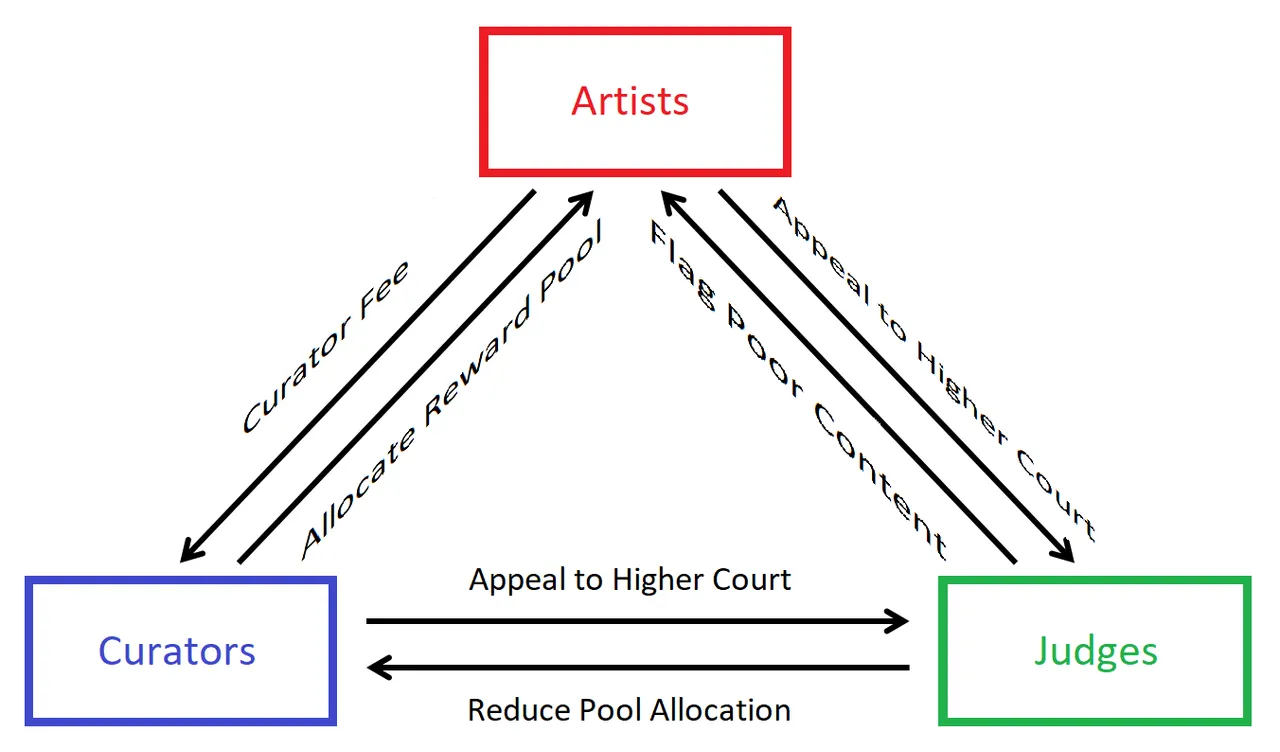
(I was pretty surprised how difficult it is to rotate text without a skew. I can fix it later.)
Checks & Balances
As you can see, here at Steemit there are three main 'occupations': artist, curator, and judge.

Artists
Artists are the creative content producers; bloggers, vloggers, photographers, memers, painters, etc. Artists are the backbone of the blockchain; the reason people come to the site in the first place; to be entertained or informed. Artists have the most important job, and therefore are awarded the majority of the reward pool.

Curators
The primary job of the curator is to upvote good content in general. High ranking curators are professionals at upvoting good content, while at the same time not allocating too much reward to a single post. Because of this, combined with the fact that Steem Power should not be available for purchase, it is curators who should be in charge of distributing 100% of the reward pool (74% of all inflation generated on the blockchain). This is the only way to insure that the highest rewards are distributed to the best content.
The secondary job of the curator is to find talented struggling (minnow) artists and bring them into the limelight. For their services, curators are paid with a percentage of the struggling artist's reward. It is my opinion that curator rewards should be doubled from (0-30 min; 0-25% reward) to (0-60 min; 0-50% reward). This will give a lot more incentive for people to wade through all the bad content to find the diamonds in the rough. Also, as incentive to reward whale/dolphin posts, I think that curators should be awarded a minimum 1% fee (more on this later).

Judges
Judges are responsible for flagging inappropriate content produced by artists, and making sure curators don't allocate too much reward to undeserving content. Once content has been flagged with enough weight, the accused party has a choice to make: accept punishment (no contest) or risk doubling the fine to appeal to a higher court. If the case is taken to court, other judges are used to decide the outcome.
This would be the smallest and most powerful branch of our Steemit government. As such, they would be rewarded with the smallest part of the reward pool (1%). I believe that the fear of justice alone is enough to keep the majority of Steemians in line. Strong activity in this branch would be an obvious indicator that something is wrong with the system.

This system really comes together when combined with my posts about bringing trial by jury to Steemit and having three different reputations. In short, there would be three separate reputations on Steemit per user; one for each job. Steem Power is a measure of community trust, so each reputation would be awarded Steem Power when the user proves themselves in that area.
Steem Power could be powered down, but never powered up. This would vastly improve the option to get paid in all SP because it is a valuable commodity that can be sold but not purchased. By getting paid in all SP, you are telling the community that you deserve to be trusted, because you don't want to sell out.
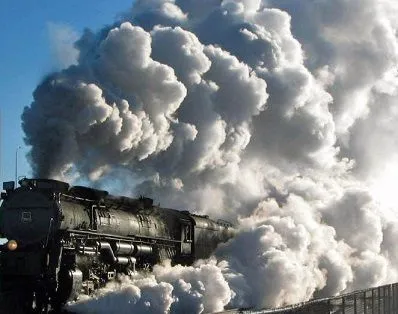
Gaining Steem Power
Acquiring SP for artists would be the same as it is now, except you can't buy it. This makes for an easy transition.
In order for a Judge to acquire SP they must flag content justly or vote for the winning side of a trial.
Curation seems a bit tricky because whales and dolphins should be getting the majority of the reward pool. Yet, what incentive do curators have of giving whales and dolphins rewards if they receive no SP in return? It is this debacle that leads me to believe that there should be a guaranteed curation fee of 1%. Every upvote would receive a minimum return of 1%.
In addition, shouldn't resteeming a post grant curation rewards? Isn't this practically the definition of curation? When a posts gets upvoted because it was resteemed by another user it would be easy to give that other user their due curation fee. It's exactly the same as online advertising and affiliate programs.
Losing Steem Power
In most situations, losing Steem Power involves being forced to power down a certain amount, rather than actually losing currency. The amount is a fine determined by judges, or a predetermined value in 'no contest' situations.
If an artists posts inappropriate content, let's say plagiarism, they may be forced to power down a little. If curators award too much to an undeserving post, they may be forced to power down a little. If judges turn out to be on the wrong side of justice, they may be forced to power down a little.

On to Specific Perks
As it stands now, Steem Power is a measure of how much of the reward pool one can distribute. However, under my plan, only curators can distribute the reward pool. You might be thinking, "What is the point of Steem Power for the other reputations?" I'm glad you asked. Each job would receive different perks based on their function in the community.
Artists with high SP would have a higher chance of their posts being viewed. About a week ago I made a suggestion for a weighted search lottery for what order posts show up in. Higher SP as an artist would also raise your flag threshold, making it harder for judges to initiate a case against you.
Curator SP advantages are obvious: They get to distribute the reward pool and rake a fee for themselves. They also receive a higher flagging threshold based on SP.
Judges with higher SP have higher flag weight. For a case to be considered a flagging threshold must be breached. Therefore, judges with higher SP bring an accusation closer to trial. However, Curators and artists with higher SP have higher thresholds, and therefore are harder to accuse. Judges with higher SP also have a higher chance of being selected for jury duty.
In summation, each job receives two benefits for acquiring Steem Power. The first benefit is a primary perk while the other is secondary in nature.
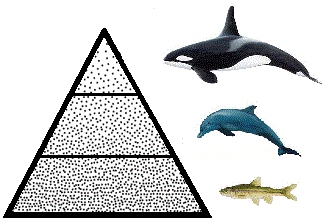
Minnows, Dolphins, and Whales
All three jobs on Steemit would have minnows, dolphins, and whales. We expect somewhat even distributions all across the boards. However, we should define what a minnow, dolphin, and whale really is because it's going to matter later with my explanation of court. On my own I came up with the bottom 50% are minnows, middle 40% are dolphins, and top 10% are whales. These exact numbers were actually confirmed by the first web site I checked so I think I'll just roll with it.
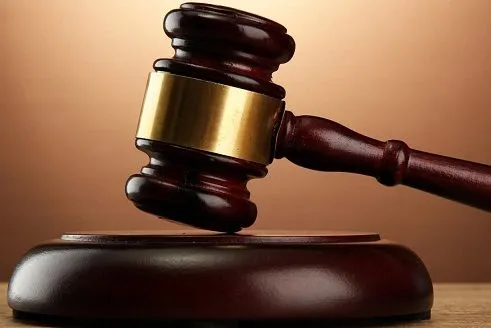
Court Explained:
There are three levels of court.
- Tribunal Court (minnow judges)
- Appeals Court (dolphin judges)
- Supreme Court (whale judges)
When an artist (or a group of curators) is flagged with enough weight to invoke a trial they have one of two options. Either they can accept their fine (power down or reward loss) or appeal to a higher court.
I've gotten a bit lost in theorycrafting and need to come up with real examples:
Example #1: Accusing an Artist
Bob Ross is an artist on Steemit. Bob posts a lovely painting of a landscape and starts getting upvotes. As an artist, Bob has 1000 Steem Power, so let's say he has a flag threshold of 5000. A judge with 500 Steem Power (500 flag weight) comes along and flags Bob for plagiarism. Nothing happens. Another judge flags Bob's painting for plagiarism for 2000 weight, nothing happens. Finally, another judge flags the post for 2501 weight. Now the flag weight is greater than the flag threshold. (5001 > 5000)
Bob is sent a notification of the accusation, he has a decision to make. He can either power down 5 SP or 1% of his total artist SP (10), or he can take the case to court and double his possible fine to 10 SP / 2%. Bob knows he is innocent. His work is original, so he takes the case to tribunal court.
26 active online judge minnows are asked to join the jury for the case. The first 13 that opt in are now the jury for this case. If 13 do not come forward fast enough 26 more will be asked. The chance of the minnow being asked is directly proportional to their flag weight. If you had 300 Judge Steem Power as a minnow and the total SP in the active judge minnow pool was 300,000 you'd have a 0.1% chance of being selected each time a slot opened (26 times total on the first wave for 2.6% chance total).
The trial begins. Bob presents evidence of his innocence. He has a video of himself painting the landscape. One of the flagging judges also presents evidence against Bob. It's a very similar looking painting by a different artist.
The Tribunal Court convicts Bob of plagiarism and sentences him to the maximum fine (10 SP or 2%). Bob can't believe it! He is innocent! He appeals to the next level of court: appeals court. Now his maximum fine is set to 20 SP or 4%.
The Appeals Court gathers 9 dolphin judges the same way tribunal court did. Higher courts have fewer judges because the pool is smaller. Bob is convicted again! However, this time the appeals court decides to offer Bob a deal. Instead of the max fine he is offered the original fine of 5 SP or 1%. Bob says F*** that and appeals to supreme court and increases his risk to 40 SP / 8%.
5 Judges gather for Supreme Court. They are are whales. It doesn't look great for Bob that he refused the appeals court deal. Is he a troll just trying to waste the Court's time? If so, he should just receive the maximum fine and be done with it. The decision of Supreme Court is final, no more appeals. What are the odds that the system has failed three times already? (flaggers, tribunal, and appeals) However, Bob does extra research to show why his painting is not plagiarism. He gives this extra evidence to the court. The Supreme Court decides that Bob is in fact innocent of the charges. Hooray for Bob!
Now that Bob has been declared innocent one problem remains. When a case gets overturned like this a decision has to be made whether there was corruption in a lower court. Was it just a misunderstanding or are people trying to frame Bob? In this situation it was probably just a misunderstanding because the case made it so far. Those two paintings did look very similar after all. Also, the jury was selected randomly so what are the odds that 2 different trials could have been corrupt?
This concern is much more relevant in tribunal court because it's much more likely that the flagging judges were corrupt compared to the flagging judges in addition to one or two trials being all corrupt. In the case of false flagging (frame job) the judges involved should be fined the same amount that they condemned the accused for.
Example #2: Accusing a Group of Curators
Joan, Michael, and Samantha are all whale curators. In that order, they upvote a high quality post from $250 payout to $400 payout. A whale judge comes along and thinks that this post is good but is receiving too much of the reward pool, so he flags it for a max payout of $250. The threshold for this flag is the summation of all accused curators thresholds added together. The thresholds are based on the payout, so a high ranking curator can't throw $1 on a post and increase the threshold by their total weight as a curator. For simplicity, let's say the total threshold is 30,000. 10,000 per curator and $50 per curator. Several other judges flag for curation as well. Some set the flag at $300 and some at $350.
All the flagging judges agree that the post has been rewarded too much but all the amounts are different. The one thing they all do agree on is that Samantha, the most recent curator, is in the wrong. Therefore, once the total flag weight reaches 10,000 the accusation will be valid and she'll have to decide to take the 5 SP or 1% fine or fight the judgment in court for double the risk. If she loses the trial she'll be powered down by the fine and the post will lose her upvote and her flag threshold. If she wins the trial her flag threshold will double, and in order to take it to the next level of court more flags will need to be put into place.
- Curation flagging needs more thought put into it. There are glaring irregularities but this is just the generic idea. For example, minnow curators need to be lumped together so that a bunch of separate trials don't start over the same post.
Example #3: Corruption Charge
Average Joe is found innocent in tribunal court. The tribunal court accuses the flagging judges as false flaggers. All the false flaggers now have the option to pay their fine or quadruple the risk by appealing to a higher court in a single shared case. In this case, the max fine is increased by x4 instead of x2 because the flaggers are claiming that tribunal court is corrupt, so it automatically goes to appeals court.
As you can see, at some point this needs to be stopped from turning into a never ending circle of accusations. This is why corruption accusations move up the chain quickly to the final decision of the Supreme Court. No matter what the Appeals Court decides in this case, the losing faction (Flaggers / Tribunal) has the option to bring it to the Supreme Court, albeit for a gigantic fine risk.
Flat Fee vs Percentage Fee
It should be noted that in my example I dabbled with flat fees and a percentage fees. I'm not sure if flat fees have much value because they are too much for a minnow and not enough for a whale. However, I am fairly certain blatant repeat offenses in a short amount of time should yield increased fines.
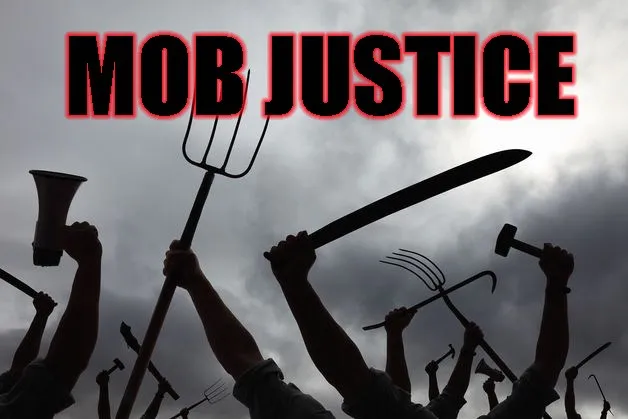
Point of Failure Corrected by Mob Justice
As it stands, the single point of failure in this system is the Supreme Court. Whatever they say goes. Most of the checks and balances of the system revolve around the Judicial branch, which is fine because everyone on the site is a potential judge and this branch is only supposed to be used as a last resort. Also, if you can't trust the most prominent people in the community, who can you trust? However, it would be nice if the Supreme Court had a check of it's own.
Anyone wanting to challenge a Supreme Court ruling could initiate 'Mob Justice'. This would double their fine yet again and, if they lose, would be guaranteed to charge the maximum fine possible. Everyone on the site would have an overall Steem Power rating equal to all their Steem Power ratings combined. In order for a Supreme court verdict to be overruled a huge percentage of the community would have to be in disagreement with them. I figure anywhere around 2/3 to 3/4 of the total Steem Power of the entire voting pool would have to disagree with the Supreme Court for them to be overturned and fined. No one should vote against the Supreme Court unless corruption is obvious.
Abuse of Judicial Power
It would be very frowned upon for a whale judge to use their vote to initiate a trial against minnows without the backup of other judges. Judges should be looking for confirmation from their peers when making accusations. Judges would be able to limit their voting power just like we can now to avoid looking like power hungry trolls. In extreme circumstances this abuse should be viewed as an infraction worthy of it's own separate trial if an unjust pattern can be established.
Appeal Denied
Obviously, every account in the community should not be able to appeal three times and force the Supreme Court to rule on podunk cases. Accounts that can't even pay the flat fine should never be considered for appeal. I'm not sure what the exact rules should be here, but I do think that the community should weigh in. Eventually, the community being able to vote on new or existing "laws" could be very useful in the distant future.
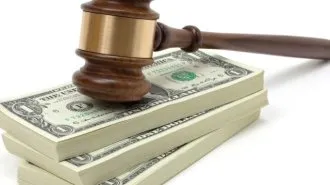
Real Fines
Clearly, real fines would produce better results due to the greater risk of actual currency being at stake, and not just reputation power downs. I keep going back and forth about whether to use real fines instead of forced power downs. A real fine would be taken from the guilty party and either fed back into the reward pool or given to the judges that flagged them.
Jury members should never be paid like this to avoid conflict of interest. As stated, I believe that the Judicial branch could operate off off as little as 1% of the reward pool. I imagine they would all get an even cut for every positive participation. However, higher courts should perhaps be paid more. Exact numbers evade me.
Perhaps with this in mind whales should be 20%, dolphins 30%, and minnows 50%. This way each court would get an even cut and each judge would get an even cut, but the payouts between courts would be different. This is especially true because higher courts have smaller juries and less trials. I could even see a 33.33% even split working. Again, exact numbers should probably be decided by community voting and eligible for change every once and a while, just like real law.
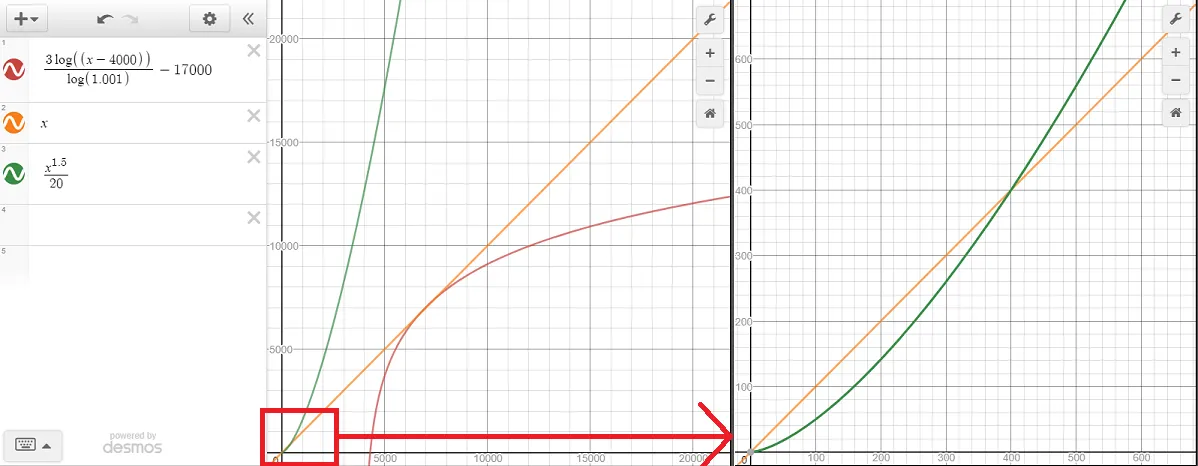
Parabolic Openers and Logarithmic Soft Caps
In a previous post I describe the value of manipulating Steem Power's weight with equations. This principal stands on its own, and would greatly decentralize the platform with a logarithmic soft cap, while at the same time forcing new accounts to prove their worth to the community with parabolic openers. Combining this mechanic with my proposed system would improve it as well for the same reasons.
Applying rewards based on even distribution
In a previous post I discuss the value allocating the reward pool only to posts that have an appropriate distribution of upvotes. This principal is especially important in my plan, because without it curators will simply upvote random hour old posts to reward themselves with 25% to 50% of the curation fee. We wouldn't want to completely rely on the court system to combat this flaw. Curators shouldn't receive their fee if they don't have the upvotes to back it up. This rule should be even more strict on curators payouts than it is on artist payouts, to promote decentralization. It is through systems like these that we can truly identify the best curators on the site. Do you want to take a chance on curating a high quality minnow post for huge rewards, or do you want to play it safe and upvote a whale for your puny <1% cut?

Transition:
Like I said, I want to form a coalition to fork the blockchain if it doesn't get decentralized. On the other side of the coin, no one wants to reinvent the wheel. We owe it to Steemit to be realistic and give them an opportunity to change. Plus, they are so far ahead anyway it would take forever to catch up. How do we get there from here?
- The first step to transition is implementing the logarithmic soft caps and parabolic openers, along with a system for rewards based on even upvote distributions.
- The second step is to implement the three jobs and evenly split all Steem Power three ways into them for each account.
- The third step is to slowly power down the old unearned/investment SP into the savings accounts.
(Step 1 could be implemented at any time and has great value no matter what.)
I would expect this transition to take 1 to 2 years to complete.

Conclusion
A lot of investors will read into this post as a personal attack on them and their investment. This is not my intention. If I had a million dollars invested into Steem Power I would still want these changes to take place. I fully believe that these changes will create abundance for everyone involved. A million dollars would easily become a billion dollars in a relatively short amount of time. Everyone is going to want to use this blockchain if it's as fair as possible. Conversely, I have very little faith in a centralized blockchain in the long run. It will be a great pyramid scheme for a while, but nothing amazing will come of it.
Here at Steemit, we have the chance to become the worlds first virtual government based on its own worldwide decentralized currency. This could be something that goes in history books. This is no time for shortsightedness or greed. This situation will create abundance for everyone. If we don't do it someone else will, and I can guarantee I'll be jumping ship to be a part of it if I can't make it happen myself.
Any plan to decentralize the Steem blockchain is a Golden Path. I believe that the future of quickly evolving government lies in a blockchain solution. This is something humanity desperately needs in these times of exponential technological advancement. Unlike current political systems that get very little accomplished, The Blockchain will allow us to decentralize and create new groups and governments at a pace never before thought possible. You could never form a group of 10,000 people and tell America that you're going to fork the constitution and secede if they don't meet your demands. With blockchain technology, this is not only possible, but probable.
You can disagree with this plan, but it's very hard to argue with the fact that this blockchain was centralized around investors the moment it came into existence. The only way to ensure a blockchain's survival is to ensure decentralization. Plain and simple: investors have too much power. Let's make a change.